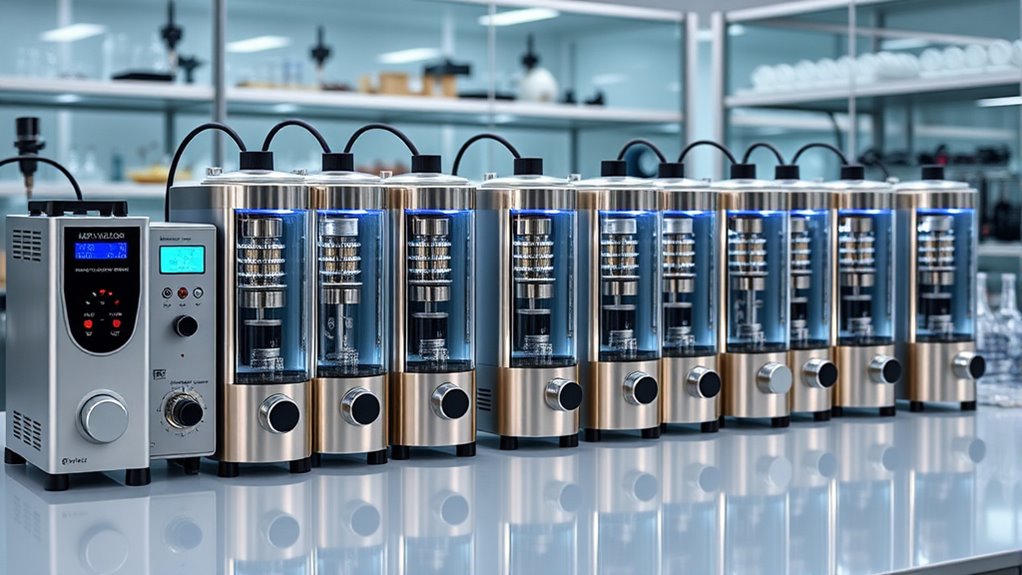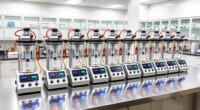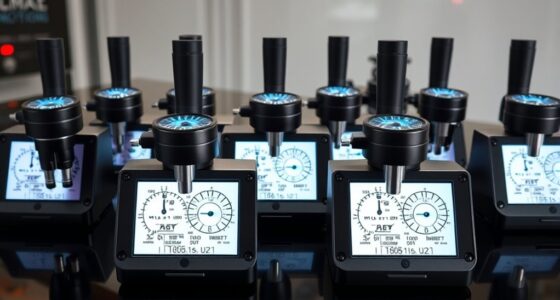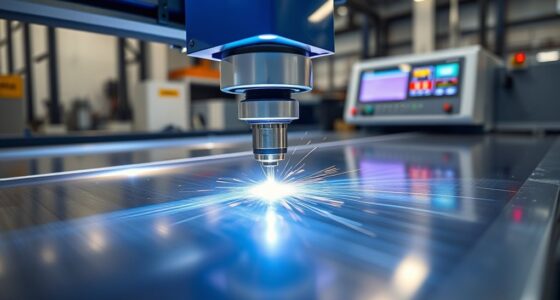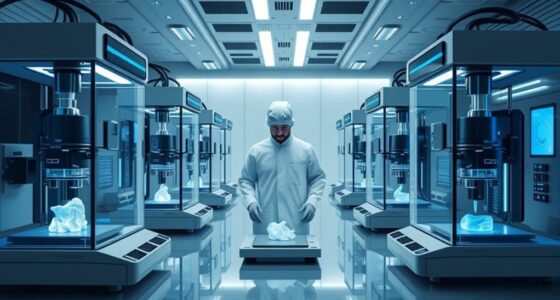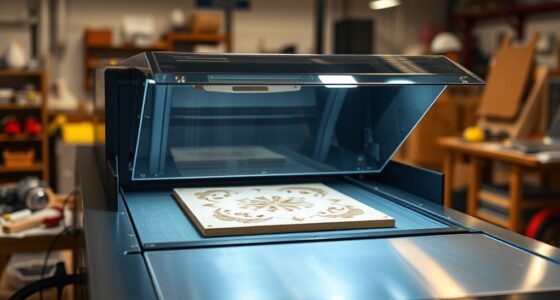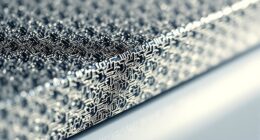When selecting the best high-vacuum pumps for labs in 2025, I focus on models that offer reliable, oil-free performance, high vacuum levels, and quiet operation. Options like diaphragm pumps, 2-stage designs, and portable units are ideal for tasks like filtration, distillation, and drying. I consider factors such as capacity, noise, durability, and compatibility with lab equipment. Keep exploring to find the perfect pump that meets your precision and reliability needs.
Key Takeaways
- Prioritize pumps with high vacuum levels (up to -95KPa) and reliable flow rates for precise laboratory applications.
- Focus on oil-free, maintenance-free models for contamination-free, hassle-free operation.
- Consider compact, portable designs with noise reduction features suitable for sensitive lab environments.
- Match pump capacity and connection compatibility with specific lab tasks like filtration, distillation, or drying.
- Balance performance, durability, and budget to select the most reliable and efficient high-vacuum pump in 2025.
Kamoer KCVP Portable 24V Lab Diaphragm Vacuum Pump
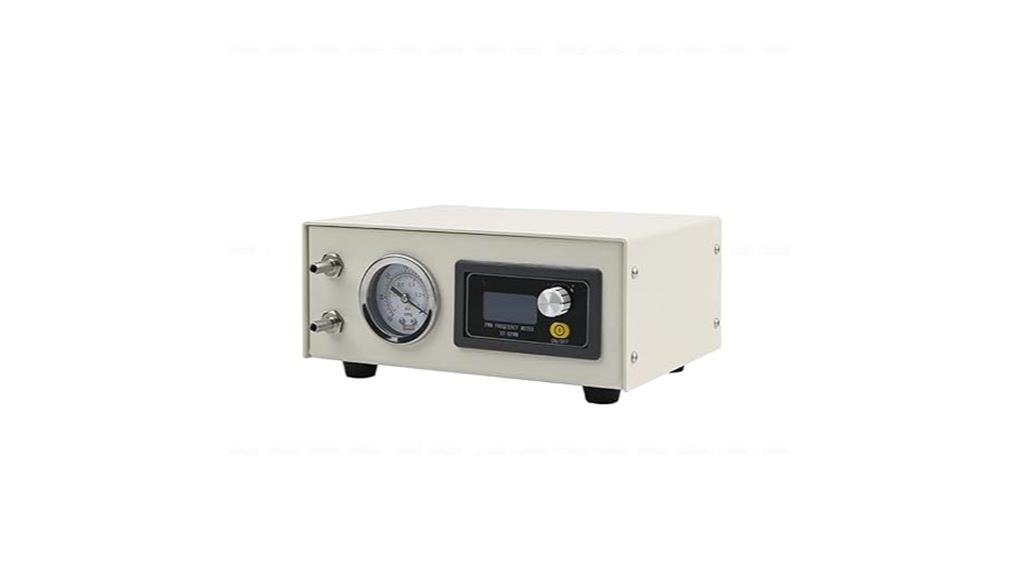
If you’re looking for a reliable, portable vacuum pump for laboratory use, the Kamoer KCVP 24V Diaphragm Vacuum Pump stands out due to its oil-free, maintenance-free design and adjustable flow rate. With a high flow capacity of up to 10L/min and a maximum negative pressure of 88KPa, it’s perfect for accelerated reagent filtration and vacuum applications. Its brushless motor ensures durability and low vibration, while the visual PWM speed control allows precise adjustments. The large dial pressure gauge provides real-time monitoring, making it easy to maintain ideal conditions. Lightweight and efficient, it’s a dependable choice for demanding lab environments.
Best For: researchers and laboratory technicians seeking a portable, maintenance-free vacuum pump for precise filtration and vacuum applications.
Pros:
- Oil-free, maintenance-free operation for hassle-free use
- Adjustable flow rate and visual PWM speed control for precise flow management
- Durable brushless motor with low vibration and real-time pressure monitoring
Cons:
- Not suitable for pumping liquids or corrosive gases
- Limited positive pressure capacity (not exceeding 100KPa)
- Requires careful handling to avoid overload and overpressure conditions
2-Stage 50L/m Oil-Free Lab Vacuum Pump

The Stage 50L/m Oil-Free Lab Vacuum Pump HZW-165 stands out for laboratories that prioritize quiet, maintenance-free operation without sacrificing performance. Its 2-stage design provides reliable high vacuum, ideal for medical, lab, and beauty applications. The pump’s smart structure and advanced soundproof casing keep noise levels as low as 55dB(A), making it suitable for noise-sensitive environments. Its oil-free mechanism requires no oil changes or regular maintenance, reducing mess and costs. Easy to install with just a silencer and filter, it delivers clean, moisture-free airflow, ensuring consistent results with minimal upkeep. This pump combines efficiency, quiet operation, and user-friendly design for demanding lab settings.
Best For: laboratories, medical facilities, and beauty salons seeking a quiet, maintenance-free, high-performance vacuum pump for air pumping applications.
Pros:
- Operates at only 55dB(A), ideal for noise-sensitive environments
- Oil-free design eliminates the need for oil changes and regular maintenance
- Easy installation with minimal setup—just attach a silencer and filter for immediate use
Cons:
- Not suitable for pumping liquids or oil, limiting its application scope
- Limited to specified air vacuum ranges; may not meet extremely high or low vacuum requirements
- Requires careful handling to ensure the inlet filter and silencer are properly maintained for optimal performance
Lab Vacuum Filtration Pump for Laboratory Filtration and Distillation

Designed specifically for laboratory filtration and distillation, the Homesprit lab vacuum filtration pump offers a reliable and efficient solution for researchers needing quick, consistent liquid processing. Its compatibility with various lab filter bottles and included flexible tubing makes setup straightforward. Made with a durable plastic shell and internal copper wiring, it’s built to last and resist rust. The pump’s shockproof rubber bases minimize noise during operation, creating a quieter workspace. Whether for filtration or distillation, this pump speeds up workflows while ensuring stability and durability, making it an excellent choice for labs seeking dependable performance in high-precision applications.
Best For: researchers and laboratory technicians requiring efficient, reliable vacuum filtration and distillation processes compatible with various filter bottles.
Pros:
- Durable plastic shell resists rust and corrosion, ensuring long-lasting use
- Flexible tubing options for versatile connections to different lab filter bottles
- Shockproof rubber bases reduce operational noise for a quieter workspace
Cons:
- Limited to laboratory environments; not suitable for industrial-scale filtration
- May require additional adapters if filter bottles have unconventional nozzle sizes
- Power cord length could restrict placement flexibility in some lab setups
Vacuum Pump 50 L/Min with Switch for Laboratory Electronics Industry
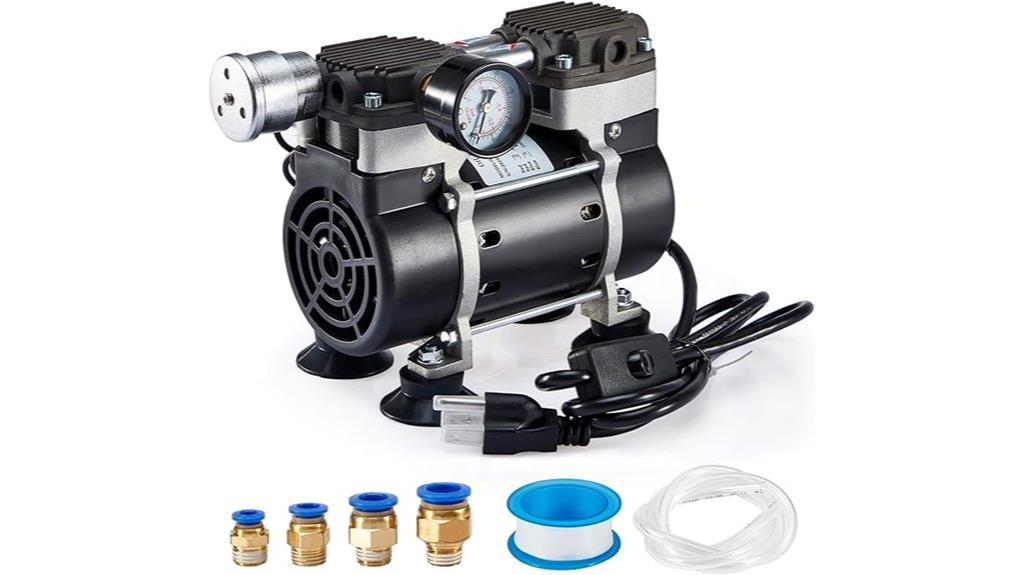
For laboratory professionals seeking a reliable and easy-to-use vacuum pump, the 50 L/Min model with switch stands out as an ideal choice. Its oil-free, maintenance-free design simplifies operation, while the compact aluminum alloy construction makes it lightweight and portable. The integrated on/off switch allows quick control, and the aluminum silencer reduces noise, creating a quieter workspace. Suitable for electronics, labs, and industrial applications, it delivers a steady flow rate with minimal vibration. Although it heats up during use, it cools quickly, and its durable build ensures long-term reliability. Overall, this pump offers a practical, efficient solution for small-scale vacuum needs.
Best For: small laboratory, electronics, and industrial professionals seeking a quiet, compact, and maintenance-free vacuum pump for precise and reliable vacuum applications.
Pros:
- Oil-free and maintenance-free design simplifies operation and reduces contamination risks
- Compact, lightweight aluminum alloy construction enhances portability and durability
- Integrated aluminum silencer significantly reduces noise for a quieter working environment
Cons:
- Short power cable with limited strain relief may require extension or careful handling
- Some parts, like the pressure gauge and wiring, can be fragile or prone to damage
- Pump heads can become hot to the touch, requiring cooling before handling after extended use
LICHEN Oil-Free Diaphragm Vacuum Pump with Hose Kit
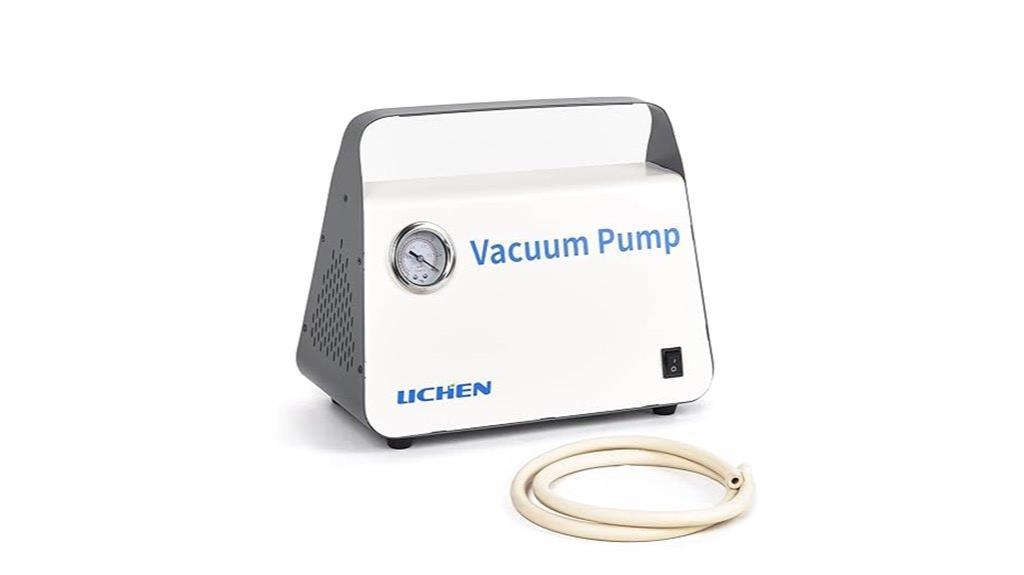
If you’re seeking a reliable, maintenance-free vacuum solution for small-scale lab tasks, the LICHEN Oil-Free Diaphragm Vacuum Pump with Hose Kit is an excellent choice. Its oil-free design prevents contamination and reduces costs, while dual pressure modes support both positive and negative pressure up to 0.085 MPa. Weighing just 5.2 lbs, it’s portable and easy to handle, with a quiet, durable brushless motor that extends lifespan. Capable of pulling up to 25 Hg of vacuum at 15 L/min, it’s perfect for solvent filtration, distillation, and extraction. Its simple operation, external power supply, and compatibility with various setups make it ideal for small labs and hobbyist use.
Best For: hobbyists and small-scale laboratories seeking a reliable, maintenance-free vacuum pump for solvent filtration, distillation, and extraction tasks.
Pros:
- Oil-free and eco-friendly design prevents contamination and reduces lab costs
- Compact, lightweight, and portable with a user-friendly external power supply
- Quiet operation with durable brushless motor and stable vacuum performance
Cons:
- Limited vacuum depth makes it unsuitable for heavy-duty industrial applications
- External power supply may be inconvenient for some users
- Not designed for long-term, continuous professional or industrial use
Lab Diaphragm Vacuum Pump with Rubber Tubes
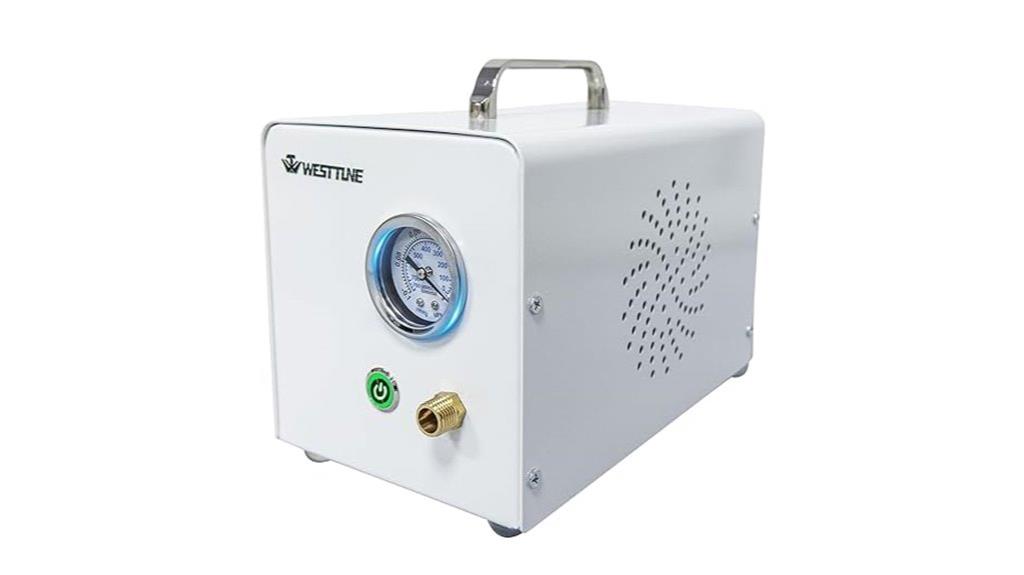
Looking for a reliable vacuum pump that simplifies laboratory filtration tasks? The Lab Diaphragm Vacuum Pump with Rubber Tubes is a portable, oil-free option designed for ease and efficiency. It features two types of rubber tubes, negative pressure capability, and a flow rate of 10 L/min, markedly speeding up filtration processes. Its compact, lightweight design weighs just 6 pounds and includes a metal-plated handle for single-handed portability. Quiet operation is enhanced by a noise reduction device, while shock-absorbing silicone pads provide stability during use. Perfect for solvent filtration, distillation, and vacuum drying, it’s a dependable choice for any lab demanding precision and reliability.
Best For: laboratory professionals and researchers seeking a portable, efficient, and oil-free vacuum pump for filtration, distillation, and drying processes.
Pros:
- Oil-free operation eliminates the need for oil maintenance and reduces contamination risks
- Lightweight and compact design with a metal-plated handle for easy single-handed portability
- Quiet operation with noise reduction device and stable performance due to shock-absorbing silicone pads
Cons:
- Limited flow rate of 10 L/min may not suffice for high-volume applications
- Includes only two types of rubber tubes, which may require additional accessories for certain tasks
- Suitable primarily for laboratory environments; not designed for industrial-scale use
Lab Vacuum Filtration Pump
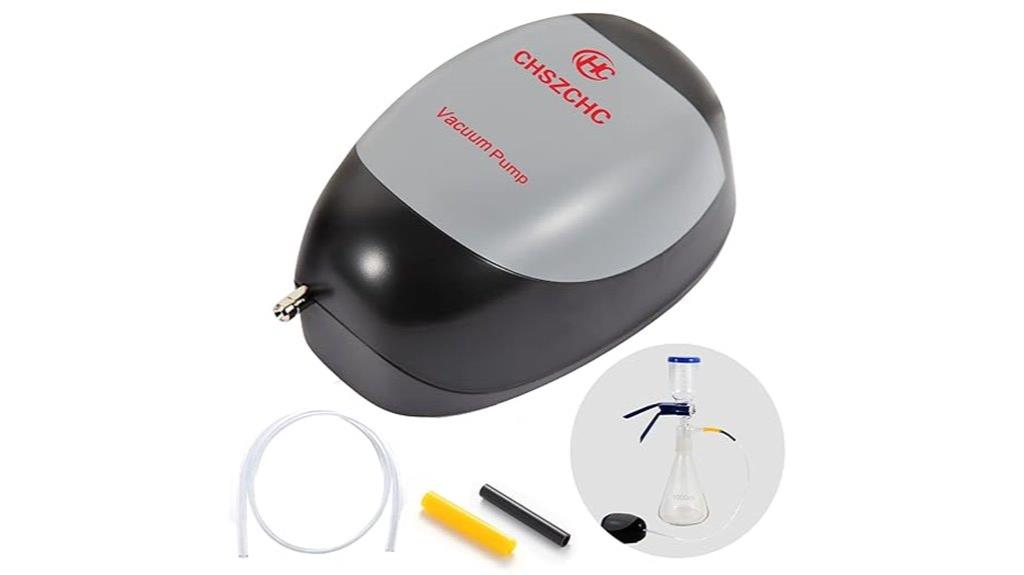
The Lab Vacuum Filtration Pump stands out as an ideal choice for routine laboratory filtration tasks that require gentle, consistent vacuum. It’s designed for quick liquid filtration, compatible with all filter bottles and suitable for distillation setups. Made of rust-proof plastic, it’s durable and quiet, with four anti-vibration rubber bases reducing noise. The pump offers flexible operation with three different diameter suction tubes, ensuring compatibility with various nozzles. It’s perfect for filtering liquids like lavender oil or wine solids, providing a gentle vacuum suited for paper filters. However, it’s less effective for oily or viscous substances and may struggle with high-resistance tasks.
Best For: routine laboratory filtration tasks requiring gentle, consistent vacuum, such as filtering liquids like lavender oil or wine solids.
Pros:
- Compatible with all filter bottles and various nozzles due to flexible tubing options
- Durable, rust-proof plastic housing with anti-vibration rubber bases for quiet operation
- Easy to use with straightforward setup, suitable for small to moderate filtration tasks
Cons:
- Not suitable for oily or viscous substances requiring strong vacuum pressure
- May experience reduced suction power over prolonged use or with high-resistance materials
- Tubing may kink or be of variable quality, potentially affecting performance
24L Oil-Free Diaphragm Vacuum Pump for Medical Use
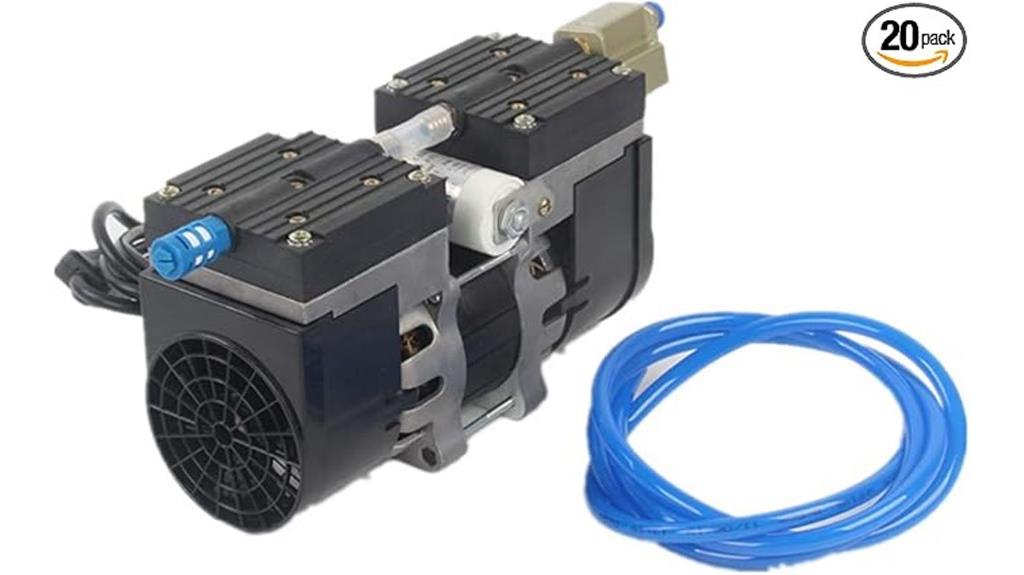
For medical laboratories seeking a reliable, contamination-free vacuum solution, the 24L Oil-Free Diaphragm Vacuum Pump stands out thanks to its oilless design and quiet operation. Its oil-free setup guarantees clean, contaminant-free airflow, reducing maintenance needs. Capable of reaching -95KPa, it handles vacuum filtration, distillation, drying, and autoclaves efficiently. The integrated air filter maintains clean airflow, while the silent operation minimizes noise disturbance during sensitive procedures. This pump is ideal for environments where purity, reliability, and quiet performance are essential, making it a top choice for medical and laboratory applications requiring consistent vacuum performance without the risks associated with oil-based pumps.
Best For: medical laboratories and research facilities seeking a reliable, contamination-free, and quiet vacuum solution for various laboratory and medical applications.
Pros:
- Oil-free and oilless design ensures clean, contaminant-free airflow and reduces maintenance.
- Quiet operation minimizes noise disturbance during sensitive procedures.
- Capable of reaching -95KPa pressure, suitable for a wide range of applications like filtration, distillation, and drying.
Cons:
- Not suitable for use with corrosion-resistant gases.
- Limited to laboratory and medical environments; not designed for industrial or heavy-duty applications.
- May require careful handling to prevent damage to delicate components during operation.
6CFM 110V Vacuum Pump with US Plug
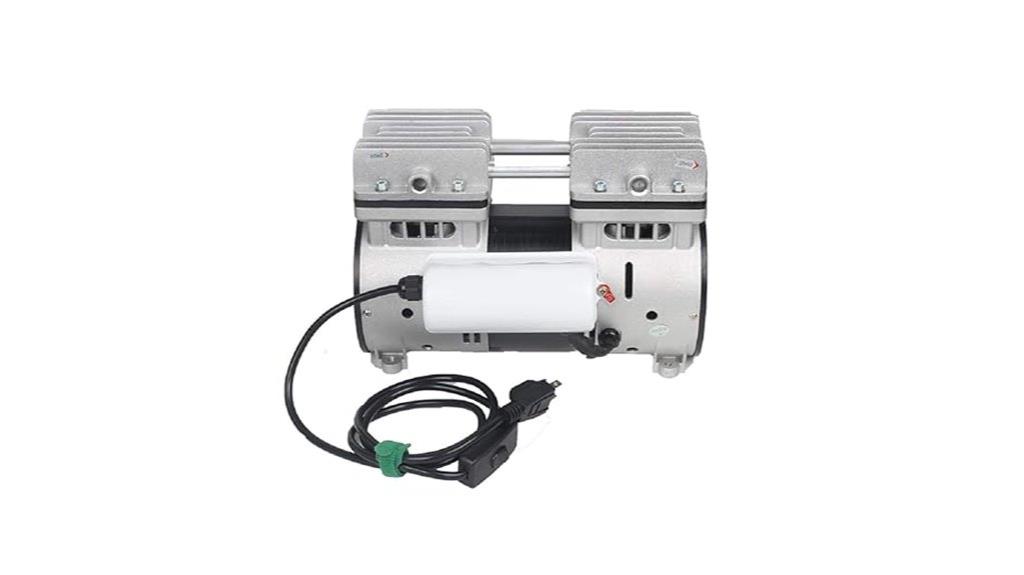
Among the top options for lab vacuum pumps in 2025, the 6CFM 110V Oil-less Vacuum Pump with US plug stands out for its powerful performance and ease of use. It features a 780W motor with a flow rate of 6CFM (100L/min) and a max vacuum of -90Kpa, making it ideal for demanding tasks. Its oil-less design with stainless steel valves reduces maintenance, while twin fans keep the motor cool. The lightweight aluminum build and quiet operation make it suitable for continuous use in various applications, from laboratory experiments to industrial processes. Overall, it’s a reliable, high-performance pump that delivers consistent, maintenance-free vacuum power.
Best For: professionals and hobbyists needing reliable, maintenance-free vacuum performance for industrial, laboratory, or DIY applications.
Pros:
- Powerful 6CFM flow rate with a max vacuum of -90Kpa for demanding tasks
- Oil-less design with stainless steel valves reduces maintenance needs
- Quiet operation suitable for continuous use in various environments
Cons:
- No on/off switch on the power cord, which may be inconvenient
- Minor cosmetic damage upon arrival, such as the fan screen
- Slightly heavy at 11KG, which could affect portability
Laboratory Vacuum Filtration Pump for USA Market
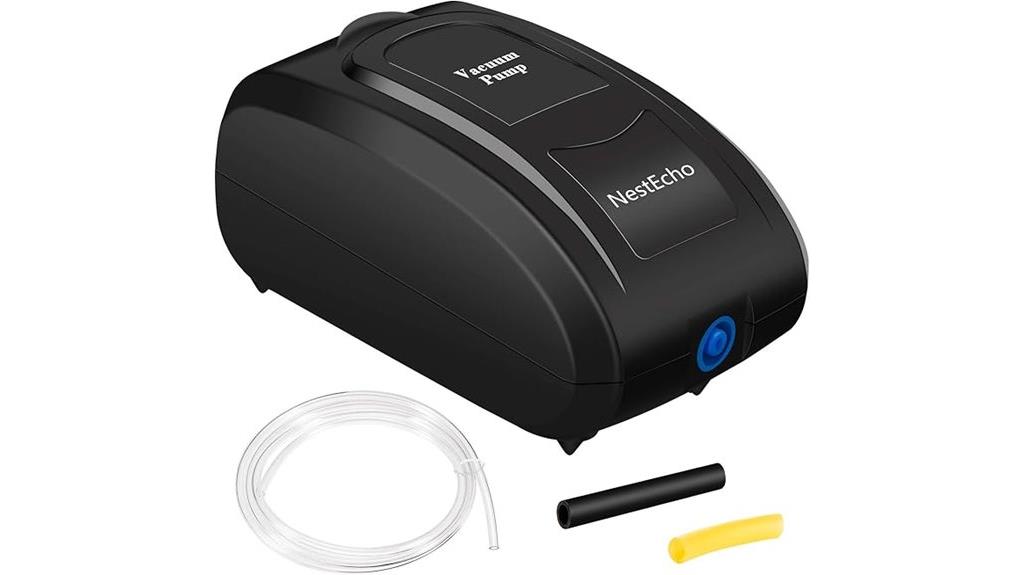
If you’re looking for a reliable vacuum pump specifically designed for the USA lab environment, the NestEcho Laboratory Vacuum Filtration Pump stands out. It operates at 110-120V, 60Hz, making it perfect for standard US outlets. This pump efficiently lowers pressure in filtration flasks, speeding up liquid filtration and distillation processes. It comes with three flexible tubing sets—transparent, black, and yellow—to connect to various filter bottles and apparatus. Built with a rust-resistant plastic shell, copper wiring, and shockproof rubber base, it’s durable and quiet during operation. If you experience poor suction, contact the seller for a replacement, and verify compatibility if used outside the USA.
Best For: researchers and laboratory technicians in the USA seeking a reliable, efficient vacuum filtration pump designed for standard US electrical outlets.
Pros:
- Specifically designed for the USA market with 110-120V, 60Hz operation.
- Made with durable, rust-resistant plastic and shockproof rubber base for long-lasting use.
- Quiet operation due to rubber base minimizes noise, creating a comfortable working environment.
Cons:
- Does not generate high vacuum suitable for advanced vacuum applications.
- Limited to use within the USA or regions with matching electrical specifications; voltage verification required elsewhere.
- Requires proper setup with compatible tubing for optimal performance, which may need user adjustment.
VIVOHOME 1.5 HP HVAC Vacuum Pump for Automotive Refrigeration

The VIVOHOME 1.5 HP HVAC Vacuum Pump stands out with its powerful dual-stage design, making it ideal for automotive refrigeration and HVAC professionals who need reliable, high-performance equipment. It delivers a flow rate of up to 14.4 CFM and can evacuate systems down to 0.2 Pa, ensuring thorough vacuuming. Its durable aluminum alloy housing, shock-absorbing non-slip base, and gas ballast valve enhance efficiency and longevity. The pump features efficient cooling with mesh vents, heat fins, and a high-power fan, plus safety filters. Easy to handle, it includes oil sight windows, drain valves, and versatile inlet fittings, making it a practical choice for demanding refrigeration tasks.
Best For: HVAC and automotive refrigeration professionals seeking a reliable, high-performance vacuum pump for demanding systems and applications.
Pros:
- Powerful dual-stage design with a flow rate of 14.4 CFM for thorough vacuuming
- Durable aluminum alloy housing and effective cooling features extend lifespan and performance
- User-friendly with visible oil window, drain valve, and versatile inlet fittings for easy maintenance
Cons:
- May be heavier and bulkier compared to smaller, portable vacuum pumps
- Requires regular oil checks and refills for optimal operation
- Slightly higher initial cost due to advanced features and build quality
Rocker 300 Oilless Vacuum Pump
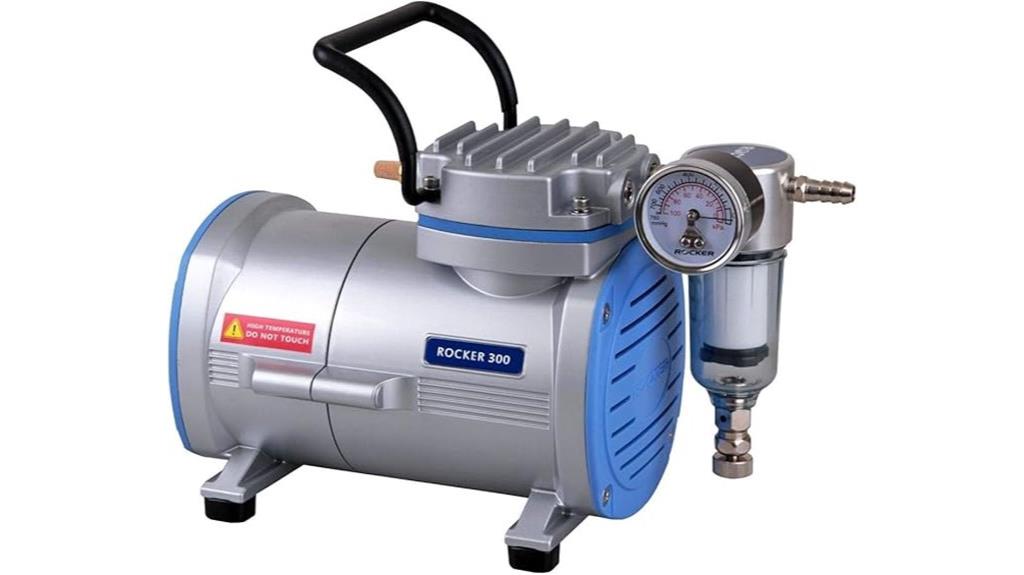
Looking for a reliable laboratory pump that offers maintenance-free operation and consistent performance? The Rocker 300 Oilless Vacuum Pump by Sterlitech fits the bill perfectly. It delivers a 99 mbar vacuum with a flow rate of 23 LPM, running at 1750 RPM, and is built from polypropylene and stainless steel for durability. Its oilless piston design ensures quiet, hassle-free operation, suitable for continuous use in applications like filtration, microbiological testing, and air sampling. Weighing just 9.5 pounds, it’s easy to handle and maintain. Users praise its reliability, quick recovery times, and quiet operation, making it an excellent choice for demanding laboratory environments.
Best For: researchers and laboratory professionals seeking a durable, maintenance-free vacuum pump for continuous filtration, microbiological testing, and air sampling applications.
Pros:
- Maintenance-free piston operation ensures hassle-free, quiet performance
- Robust construction from polypropylene and stainless steel for durability and long-term use
- Quick recovery times and reliable moisture removal facilitate efficient workflow
Cons:
- Check valves may require monitoring and occasional replacement to maintain maximum vacuum levels
- Slightly limited maximum vacuum compared to higher-end models
- No battery or portable power option; requires 110V AC power supply
Factors to Consider When Choosing High‑Vacuum Pumps for Labs
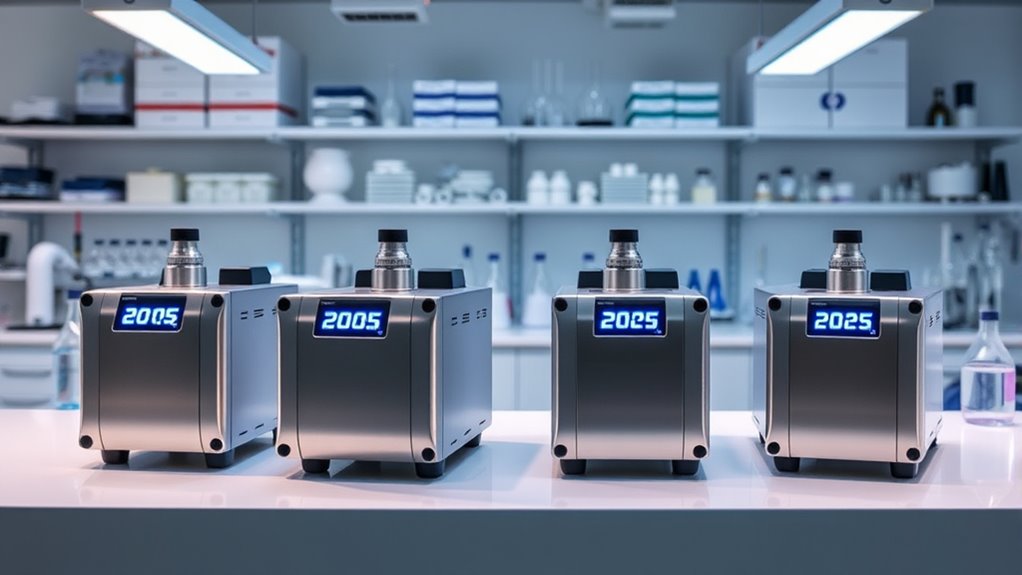
When selecting a high-vacuum pump, I consider the volume of work it can handle and how loud it might be during operation. I also look at how easy it is to maintain, whether it matches my lab’s power setup, and if it’s suitable for my specific applications. These factors help me choose a pump that’s reliable and fits my needs perfectly.
Pump Capacity Needs
Choosing the right high-vacuum pump starts with understanding your application’s flow rate requirements. I recommend determining the maximum flow rate your process needs—like 10 L/min for small filtration or 50 L/min for more demanding tasks. Match the pump’s capacity to your system’s volume, ensuring it can reach your target vacuum level efficiently. Consider if your workflow requires continuous operation or intermittent use, as this influences capacity choices. Oversizing the pump leads to unnecessary energy use and noise, while undersizing risks inadequate vacuum performance. It’s also important to verify that the pump’s flow rate aligns with your equipment’s specifications to avoid inefficiencies or damage. Correctly matching capacity guarantees reliable, efficient operation tailored to your lab’s specific needs.
Noise Level Tolerance
Evaluating the noise level of a high-vacuum pump is key to maintaining a comfortable and efficient lab environment. Pumps are measured in decibels (dB), with quieter models producing 55-68dB, ideal for noise-sensitive settings. If the lab requires continuous operation, choosing a pump below 60dB helps prevent disruption and fatigue. Many pumps feature noise reduction technologies like mufflers, soundproof casings, or vibration damping, which further lower operational noise. Be mindful of your lab’s ambient noise standards and regulations—exceeding 70dB can cause discomfort and communication issues during extended use. Balancing noise levels with other performance factors ensures a setup that promotes productivity without sacrificing comfort. Ultimately, matching your pump’s noise output to your environment is crucial for peak lab functioning.
Maintenance Requirements
Considering maintenance requirements is vital to selecting the right high-vacuum pump for your lab, as different models have varying upkeep needs. Oil-based pumps need regular oil changes, oil level checks, and filter cleaning to guarantee optimal performance. In contrast, oil-free pumps like diaphragm or dry models require less maintenance but still need periodic inspection of seals and diaphragms for wear. Pumps with mechanical components such as check valves or seals may need occasional servicing or replacements to prevent vacuum loss or system failure. Keeping to manufacturer guidelines and scheduling routine maintenance are essential for extending pump lifespan, maintaining consistent performance, and avoiding costly repairs. Understanding these requirements helps you choose a pump that balances ease of upkeep with your lab’s precision and reliability standards.
Power Compatibility
Ensuring your high-vacuum pump’s power compatibility is crucial for safe and efficient operation in your lab. First, verify that the voltage and frequency of the pump match your power supply to avoid operational issues or damage. Check the pump’s power rating—whether it’s 20W, 180W, or 780W—and confirm your electrical capacity can handle it without overload, ensuring ideal performance. Additionally, consider local electrical standards, such as 110V in the US or 220V in Europe, to prevent mismatches. Don’t forget to review the plug type and connector compatibility with your outlets for easy installation. Finally, assess whether the pump’s power requirements align with its intended use, like continuous operation or short bursts, to choose the right power class.
Application Suitability
Choosing the right high-vacuum pump depends largely on your lab’s specific applications. You need to guarantee the pump’s maximum pressure and flow rate match your requirements, whether for filtration, distillation, or drying. Check that the pressure range suits your tasks—some processes need gentle vacuum, while others require deep evacuation. Compatibility with existing equipment is also vital; confirm the tubing sizes and connection types fit seamlessly to prevent leaks. Additionally, consider the vacuum type—oil-free, oil-based, diaphragm, or rotary vane—based on contamination control and maintenance needs. Finally, evaluate whether the pump can operate continuously or intermittently without performance issues, aligning with your workload demands. Proper application suitability ensures reliable results and efficient operation.
Budget Constraints
Budget constraints can markedly influence your choice of high-vacuum pumps, often limiting you to models that are more affordable but still meet your lab’s core needs. Lower-cost pumps typically have smaller capacity and fewer advanced features, so you need to weigh what’s essential for your work. High-performance pumps with extra features like oil-free operation or enhanced durability tend to cost more upfront but may save money long-term through reduced maintenance. It’s also wise to budget for replacement parts or upgrades, as cheaper models might have shorter lifespans. Striking a balance between cost and specifications—such as maximum vacuum pressure, flow rate, and noise level—is vital. This approach ensures you select a pump that’s both affordable and capable of supporting your lab’s specific requirements.
Frequently Asked Questions
What Maintenance Is Required for High-Vacuum Pumps in Labs?
I regularly check and replace the pump oil to keep it clean and functioning smoothly. I also inspect seals and gaskets for leaks, ensuring they’re in good condition. Cleaning the pump’s exterior prevents dust buildup, and I monitor vibration and noise levels for signs of wear. Additionally, I run routine vacuum tests to confirm peak performance. Consistent maintenance like this keeps my high-vacuum pump reliable and efficient.
How Do Noise Levels Affect Vacuum Pump Selection?
Noise levels are vital when choosing a vacuum pump because loud pumps can disrupt lab environments and cause discomfort. I prefer quieter models to maintain focus and safety, especially in shared spaces. Lower noise levels often indicate better engineering and less vibration, which can extend the pump’s lifespan. So, I always check noise specifications and opt for pumps designed to operate quietly without sacrificing performance.
Are There Specific Safety Protocols for Using Oil-Free Pumps?
Yes, there are specific safety protocols for using oil-free pumps. I always guarantee proper ventilation, wear protective gear, and follow manufacturer guidelines to prevent accidents. Regular maintenance and inspections are vital to keep the pump functioning safely and efficiently. I also make sure to handle any electrical components carefully and avoid exposure to potentially hazardous materials. Staying vigilant and adhering to these protocols helps me ensure a safe working environment.
What Is the Typical Lifespan of a High-Vacuum Pump?
Typically, I find that high-vacuum pumps last around 3 to 10 years, depending on usage and maintenance. Regular servicing, oil changes, and operating within recommended parameters can extend their lifespan. I always monitor performance indicators and follow manufacturer guidelines to catch issues early. Proper maintenance and timely replacements guarantee my pumps stay reliable and efficient, ultimately saving me time and money in the long run.
How Do Pump Size and Power Impact Laboratory Workflow Efficiency?
When I upgraded to a larger, more powerful vacuum pump, my lab’s workflow improved markedly. Bigger pumps handle larger volumes faster, reducing downtime. For example, in a recent project, a high-capacity pump cut processing time by half, enabling quicker results. So, pump size and power directly boost efficiency by speeding up processes, minimizing delays, and handling higher workloads seamlessly. It’s all about matching pump specs to your lab’s specific needs.
Conclusion
Just like Da Vinci’s pursuit of perfection, selecting the right high-vacuum pump means balancing precision and reliability. With these top picks, you’re equipped to elevate your lab’s performance, ensuring every experiment and process reaches new heights. Remember, the right tool isn’t just about power—it’s about trust and consistency. Choose wisely, and let your scientific journey be as groundbreaking as the masterpieces of the past.
